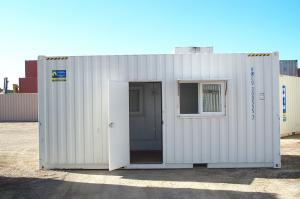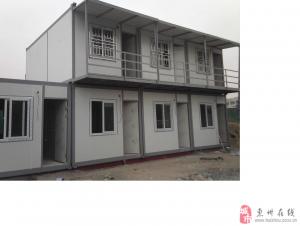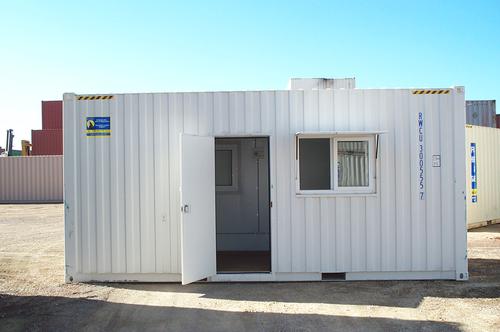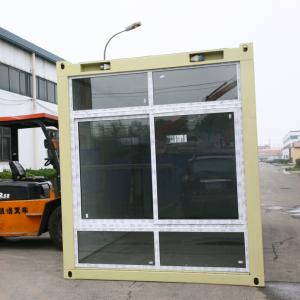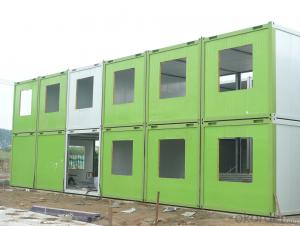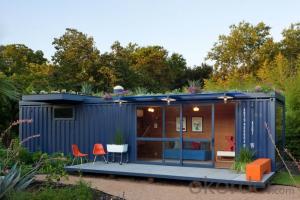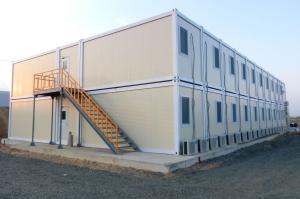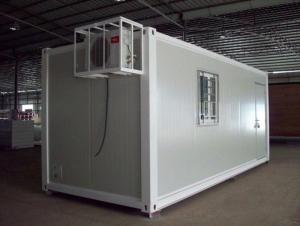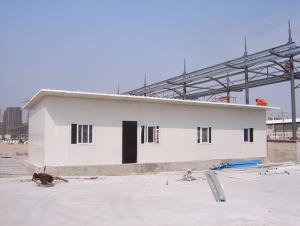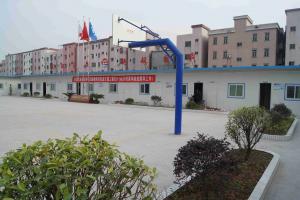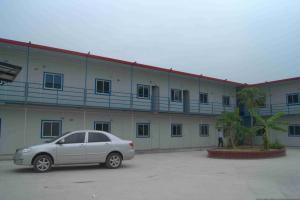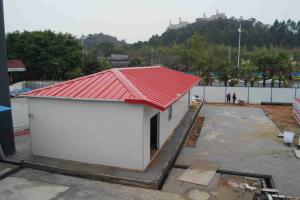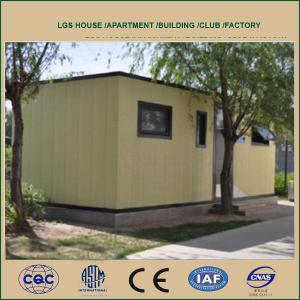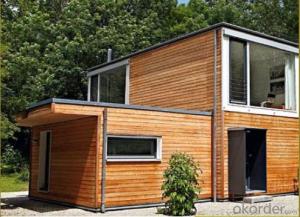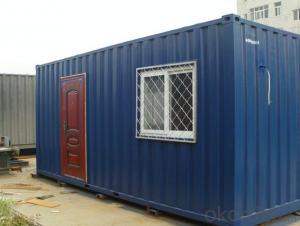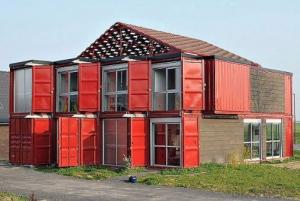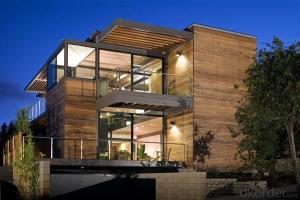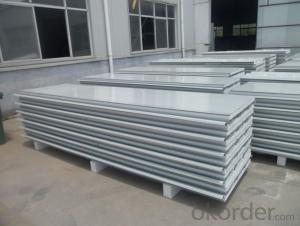Prefabricated Steel Structure Container Home 001 Style
- Loading Port:
- Shekou
- Payment Terms:
- TT or LC
- Min Order Qty:
- -
- Supply Capability:
- 500 set/month
OKorder Service Pledge
OKorder Financial Service
You Might Also Like
Prefabricated Steel Structure Container Home 001 Style
1.Structure of Prefabricated Steel Structure Container Home 001 Style
Prefabricated Steel Structure Container Home 001 Style is one kinds of the normal buildings nowadays. Its components are manufactured in the factory and prefabricated before entering the site, even can be installed in the workshop before transporting to the building location.
2.Main Features of Prefabricated Steel Structure Container Home 001 Style1) Easy to assemble and disassemble with simple and common tools.
2) Good waterproof performance without extra facilities.
3) Good fireproof performance with rockwool sandwich panel.
4) Good performance of heat-insulation.
5) Safety and stable,could stand firmly over 50 years.
6) Light weight, convenient for shipment and transportation.
7) Beautiful appearance, virious colors and shapes for outer and inner roof panel and wall panel.
8) Various designs available, customized designs acceptable.
9) Wide range of application, could be used as offices, command posts, sentry boxes, dormitories, workshops,Kiosks and so on.
3. Prefabricated Steel Structure Container Home 001 Style Images

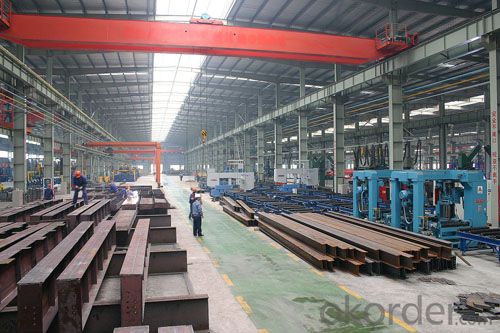
4. Prefabricated Steel Structure Container Home 001 Style Specification
1) Design according to customer's requirement.
2) Manufacture with high quality control.
3) Engineer helps to instruct installation.
4)Easy to assemble and dismantle.
5) Main materails: H beam/C purlin/Z purlin/sandwich panel/ corrugated steel sheet
6)Life: Over 50 years
7)Nice appearance, easy to maintenance.
8) Price different from USD 40 to USD 100 due to different size/design/raw materails grades, etc5.FAQ of Prefabricated Steel Structure Container Home 001 Style
We have organized several common questions for our clients,may help you sincerely:
①How about your company?
A world class manufacturer & supplier of castings forging in carbon steel and alloy steel,is one of the large-scale professional investment casting production bases in China,consisting of both casting foundry forging and machining factory. Annually more than 8000 tons Precision casting and forging parts are exported to markets in Europe,America and Japan. OEM casting and forging service available according to customer’s requirements.
②How to guarantee the quality of the products?
We have established the international advanced quality management system,every link from raw material to final product we have strict quality test;We resolutely put an end to unqualified products flowing into the market. At the same time, we will provide necessary follow-up service assurance.
③Comparing to the traditional buildings, could I know the advantage on your products?
Comfortable, energy-saving insulation sound insulation structure design, 100 mm thickness of glass wool insulation layer, the heat preservation performance is equivalent to 1 m thick brick wall, experiments show that the external wall thermal conductivity structure system is 0.46; Light steel structure can be up to 50 db sound insulation properties of the composite wall above; Excellent heat preservation sound insulation performance, not only provides residents with a healthy and comfortable living environment, and compared with reinforced concrete structure, energy saving of 60% - 70%.
- Q: Can container houses be designed for community centers or gathering spaces?
- Yes, container houses can definitely be designed for community centers or gathering spaces. The modular nature of container houses allows for flexible and customizable layouts, making them suitable for various purposes. With proper design and modifications, container houses can be transformed into vibrant and functional spaces that can accommodate community activities, events, and gatherings.
- Q: Can container houses be designed with a built-in workspace or study area?
- Yes, container houses can definitely be designed with a built-in workspace or study area. The versatile nature of containers allows for flexible and customizable designs, making it possible to include dedicated spaces for work or study within the house.
- Q: Can container houses be designed with a large outdoor patio?
- Yes, container houses can be designed with a large outdoor patio. By utilizing multiple containers or adding extensions to the structure, a spacious outdoor patio area can be created. The containers can be modified, stacked, or arranged in a way that allows for an expansive patio space, accommodating various outdoor activities and functions. Additionally, creative design solutions such as retractable roofs or folding wall systems can provide flexibility and maximize the use of the outdoor space in container houses.
- Q: Can container houses be designed with a kitchen island or breakfast bar?
- Absolutely! When it comes to container houses, the design options are limitless. You can easily incorporate a kitchen island or a trendy breakfast bar into your space. The beauty of container houses lies in their adaptability, which allows for the inclusion of different amenities and features. By adding a kitchen island or breakfast bar, not only will you enhance the functionality of your kitchen, but you'll also infuse a touch of modernity and style into your container house design. With some careful planning and innovative design, you can definitely make a kitchen island or breakfast bar a reality in your container house.
- Q: Buy a container when the house, legally allowed?
- Buy a container when the house, although it looks more avant-garde, but from the legal point of view,
- Q: Do container houses require a building permit?
- Yes, container houses typically require a building permit. The requirements may vary depending on the location and local building codes. It is important to check with the local authorities or building department to ensure compliance and obtain the necessary permits before constructing a container house.
- Q: How long do container houses typically last?
- Container houses typically last for several decades, with an estimated lifespan of around 25 to 30 years. However, this can vary depending on several factors such as the quality of construction, maintenance, climate conditions, and level of usage. Properly designed and constructed container houses that receive regular maintenance can potentially last even longer, sometimes up to 50 years or more. Additionally, some container houses are built using weather-resistant materials and undergo structural modifications to enhance their durability and lifespan. Overall, the longevity of a container house is dependent on various factors and can be extended with proper care and maintenance.
- Q: Can container houses be designed to have a rooftop bar?
- Yes, container houses can be designed to have a rooftop bar. With proper planning and design, it is possible to incorporate a rooftop bar into a container house. The strength and structural integrity of the containers can be reinforced to support the weight of a rooftop bar. Additionally, modifications can be made to create a spacious and comfortable rooftop area, complete with seating, a bar counter, and even a small kitchenette. The containers can be stacked or arranged in a way that allows for easy access to the rooftop area, ensuring a seamless transition between the interior and the rooftop bar. By utilizing creative design and engineering techniques, container houses can be transformed into unique and stylish spaces that include a rooftop bar.
- Q: What is the price of container housing?
- Luxury point, it may be two containers up and down together, so there is a balcony, a large living room
- Q: Can container houses be designed with green roofs?
- Yes, container houses can be designed with green roofs. Green roofs, also known as living roofs or eco-roofs, are designed to have vegetation planted on top of the building structure. These roofs provide numerous environmental benefits, including insulation, stormwater management, and improved air quality. Container houses, made from repurposed shipping containers, can accommodate green roofs just like any other traditional building. However, there are some considerations to take into account when designing green roofs for container houses. First, the structural integrity of the container house needs to be assessed to ensure it can support the additional weight of a green roof. Green roofs can be quite heavy, especially when soil, plants, and water are added. Reinforcements may be required to ensure the container can withstand the load. Second, proper waterproofing and drainage systems are essential to prevent water leakage into the container structure. Green roofs retain water, so it is crucial to have a well-designed system to manage excess water and avoid damage to the container. Third, container houses may have limited space available for a green roof, depending on the size and configuration of the containers. Designers and architects need to carefully plan and optimize the available space to create a functional and aesthetically pleasing green roof. Lastly, the selection of plants for the green roof should be chosen carefully, considering the local climate and the weight limitations of the container structure. Drought-resistant and lightweight plants are often preferred for container house green roofs. With proper planning, design, and implementation, container houses can indeed incorporate green roofs. This combination can contribute to sustainable living by maximizing energy efficiency, reducing environmental impact, and creating a harmonious connection with nature.
Send your message to us
Prefabricated Steel Structure Container Home 001 Style
- Loading Port:
- Shekou
- Payment Terms:
- TT or LC
- Min Order Qty:
- -
- Supply Capability:
- 500 set/month
OKorder Service Pledge
OKorder Financial Service
Similar products
Hot products
Hot Searches
Related keywords
